You are using an out of date browser. It may not display this or other websites correctly.
You should upgrade or use an alternative browser.
You should upgrade or use an alternative browser.
Do Princesses or Rounds look bigger?
- Thread starter rosy
- Start date
- Status
- Not open for further replies. Please create a new topic or request for this thread to be opened.
- Joined
- Aug 15, 2000
- Messages
- 18,484
A well cut princess 2ct spreads about 7.0 to 7.1mm square = 7x7.1 = 49.7 squared mm
A well cut round spreads 8.15 to 8.2mm = 4.09x4.09x3.142 = 52.5mm sq
that is about 5% difference.
But the bigger factors are the difference in apparent size and the likelyhood of chipping which should lead you to requiring a thicker girdle on the princess.
so to simplify it - I think a 2.5ct princess would be about the same looking size as a 2ct round.
A well cut round spreads 8.15 to 8.2mm = 4.09x4.09x3.142 = 52.5mm sq
that is about 5% difference.
But the bigger factors are the difference in apparent size and the likelyhood of chipping which should lead you to requiring a thicker girdle on the princess.
so to simplify it - I think a 2.5ct princess would be about the same looking size as a 2ct round.
- Joined
- Aug 15, 2000
- Messages
- 18,484
moremoremore
Ideal_Rock
- Joined
- Mar 15, 2004
- Messages
- 6,825
But Gary- what about surface area? A circle of the same diameter will fit inside a square of the same diameter. Doesn't that help make the princess look larger? (although still not as large as a round)
Here's another thing to think about- the 2.5 princess won't cost much more than the 2 ct round? (or is that incorrect)...Then again, I'm really turned off by most princess cuts these days (except for a few exceptional ones here on ps)
Here's another thing to think about- the 2.5 princess won't cost much more than the 2 ct round? (or is that incorrect)...Then again, I'm really turned off by most princess cuts these days (except for a few exceptional ones here on ps)
- Joined
- Aug 15, 2000
- Messages
- 18,484
would someone like to do some price comparisons acoss a variety of sizes?
- Joined
- Aug 15, 2000
- Messages
- 18,484
bump - volunteers?
- Joined
- Aug 29, 2003
- Messages
- 15,808
err... meaning $/square mm or square and round pieces ?Date: 1/6/2005 21:57 PM
Author: Garry H (Cut Nut)
would someone like to do some price comparisons acoss a variety of sizes?

- Joined
- Aug 15, 2000
- Messages
- 18,484
compare average prices for same quality rounds on a 1:1.25 carat weight basis where you compare say 0.8ct round to 1ct princess and 1ct round to 1,25ct princess etc
moremoremore
Ideal_Rock
- Joined
- Mar 15, 2004
- Messages
- 6,825
So a 1 ct round = price of a 1.25 princess? Interesting, thanks Gary.
I think that the corners of the princess def''ty draw the eye out also! And slap some V prongs on it!
The trick would be to find a princess with a great depth...say 70 and less...
Then again, you really can''t compare the look of the round to a princess. (ok, I admit it..after how many years? LOL)
I think that the corners of the princess def''ty draw the eye out also! And slap some V prongs on it!
The trick would be to find a princess with a great depth...say 70 and less...
Then again, you really can''t compare the look of the round to a princess. (ok, I admit it..after how many years? LOL)
- Joined
- Aug 15, 2000
- Messages
- 18,484
no no no - I do not know if 1ct round = 1.25 princess spread apearance
Not equivalent $ value - I was asking for someone else to do the dollar value equivalent please - as princess cost less per carat
Not equivalent $ value - I was asking for someone else to do the dollar value equivalent please - as princess cost less per carat
- Joined
- Aug 15, 2000
- Messages
- 18,484
Ok - I just did this mini survey with some staff and customers - 2 girls and 1 boy.
0.90ct Round 6.07x6.12 = 29.1mmS
1.23ct Princess 5.64x5.38 = 30.3mmS
1.07ct Round 6.59x6.63 = 33.8mmS
1.47ct Princess 6.08x5.97 = 36.3mmS
The boy thought the rounds looked heaps bigger, the girls thought the princess were a tiny bit bigger but both girls thought the 1.07ct Round was heaps bigger than the 1.23ct Princess.
So based o that - I am happy with my initial gut feel estimate of plaus 25% more for equivalent carat weight for a princess to look the same size as a round.
0.90ct Round 6.07x6.12 = 29.1mmS
1.23ct Princess 5.64x5.38 = 30.3mmS
1.07ct Round 6.59x6.63 = 33.8mmS
1.47ct Princess 6.08x5.97 = 36.3mmS
The boy thought the rounds looked heaps bigger, the girls thought the princess were a tiny bit bigger but both girls thought the 1.07ct Round was heaps bigger than the 1.23ct Princess.
So based o that - I am happy with my initial gut feel estimate of plaus 25% more for equivalent carat weight for a princess to look the same size as a round.
- Joined
- Aug 29, 2003
- Messages
- 15,808
- Joined
- Aug 15, 2000
- Messages
- 18,484
Intersting Ana - you are great at that stuff
As you can possibly see from these ameuter photo's - there is clearly an apparent size issue that makes the 1:1.25 rule work.
i have shown them to a few more people and the consensus is that the two smaller stones look similar - or the princess is slightly larger. But the 1.07ct is clearly llarger than the 1.23ct princess.
I think this brightness factor has not been incorporated into your analysis Ana?
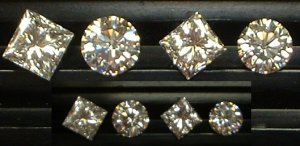
As you can possibly see from these ameuter photo's - there is clearly an apparent size issue that makes the 1:1.25 rule work.
i have shown them to a few more people and the consensus is that the two smaller stones look similar - or the princess is slightly larger. But the 1.07ct is clearly llarger than the 1.23ct princess.
I think this brightness factor has not been incorporated into your analysis Ana?

- Joined
- Aug 29, 2003
- Messages
- 15,808
!!! Well, my current boyfriend (mathematician) here asked what the heck I was doing at 5am with those charts and I started explaining that some guys asked if squares are bigger than circles... I don't want to even remember the answerDate: 1/7/2005 2:22:44 AM
Author: Garry H (Cut Nut)
I think this brightness factor has not been incorporated into your analysis Ana?

Anyway, the intuitive 25% weight difference between shapes has a counterpart on the charts too. By blind numbers, that is not 25% but 31%. Assuming the samples would be comparable (which they are not, the 25% comes from your experience which is way better than the 400 pieces sample I used), this means that the 5% "savings" between numbers and looks comes from some visual factor that has naught to do with area (="size", for the charts). You call this factor "brightness"... so brighteness be it

... one can always build an argument with numbers, for better or worse.
- Joined
- Aug 15, 2000
- Messages
- 18,484
1. would you like to transalte all that into simpleton English Ana?Date: 1/7/2005 32:41 AM
Author: valeria101
!!! Well, my current boyfriend (mathematician) here asked what the heck I was doing at 5am with those charts and I started explaining that some guys asked if squares are bigger than circles... I don''t want to even remember the answerDate: 1/7/2005 2:22:44 AM
Author: Garry H (Cut Nut)
I think this brightness factor has not been incorporated into your analysis Ana?
Anyway, the intuitive 25% weight difference between shapes has a counterpart on the charts too. By blind numbers, that is not 25% but 31%. Assuming the samples would be comparable (which they are not, the 25% comes from your experience which is way better than the 400 pieces sample I used), this means that the 5% ''savings'' between numbers and looks comes from some visual factor that has naught to do with area (=''size'', for the charts). You call this factor ''brightness''... so brighteness be it
... one can always build an argument with numbers, for better or worse.
2. Be careful or that current boy friend will become........
You should be doing other things at 5AM




- Joined
- Aug 29, 2003
- Messages
- 15,808
Kind''a tried to put together these three points:Date: 1/7/2005 3:43:47 AM
Author: Garry H (Cut Nut)
1. would you like to translate all that into simpleton English Ana?
1) observation suggests that bright Ps need to be 25% havier to look as large as bright rounds. (''bright'' stand for good optics relative to common bechmark for all stones observed)
2) statistically, well cut Ps need to be 31% havier than well cut rounds to have the same size (''well cut'' stands for AGA top two grades for both shapes)
3) from the two follows that some factor that the observer see but the numbers (size and weight) do not catch, makes those squares look larger than expected by numbers (where the 31% is the expected weight difference by numbers, and the 25% is the expected difference by eye sight). Since the numbers used do no catch the optics of these stones, well, that''s what could explain the difference.
Of course all this is... only ok for stats 101, and practiclaly no better than a little joke. Just showing how far my sense of humor goes

- Joined
- Aug 15, 2000
- Messages
- 18,484
nice try Ana - but i only give you 3/10 for making it comprehensable.
What do your charts mean - you have two sentances with less than 6 words each

What do your charts mean - you have two sentances with less than 6 words each

- Joined
- Aug 29, 2003
- Messages
- 15,808
Date: 1/8/2005 12:41:49 AM
Author: Garry H (Cut Nut)
What do your charts mean -

For both the sample was 200 rounds and 200 princess cuts all with table&depth withing AGA 1A and 1B brackets, all F, VS1, 15 to 2.5 cts.
left: compares size/weight for rounds and squares. The vertical axis give spread in square milimeters (="sqmm") the horisontal axis gives carat weight. Each point represents one diamond from the sample. The higher a point on the chart is, the bigger a diamond's surface relative to it's weight. It seems that nearly all points representing rounds hover above all points representing princess cuts - hence the six words: "rounds are a tad larger for each weight"
The persistent weight difference you mention appears as the distance between the two trendlines on this chart.
right: compares the cost of "finger cover" - that is $/square milimeter of diamond (on the vertical axis) with the size of the stones (surface area, given on the horisontal axis). Everyone keeps in mind how the price per carat goes up with carat weight, this chart says something close: how the price per surface unit goes up with size. Each point is again one diamond, and the higher the point on the chart, the more expensive a certain size (read on the horisontal axis) in that shape. The majority of rounds appear plotted above princesses, hence the respective six-word conclusion: "squares are a tad cheaper for each size"
lostdog
Shiny_Rock
- Joined
- Dec 14, 2004
- Messages
- 179
Valeria, in the second plot, $ versus size, is that actual area in square mm or just linear mm? (The horizontal axis shown runs 6 to 8mm, not the 28 to 64 that area would run. Or am I misunderstanding something? )
Similar story in the end, but the plots would shift. As is suggests a crossover point below 6.4mm, but behavior at the end of the ranges is sometimes not what it seems in regressions.
- - -
(I owe Garry some homework, too. An ill-advised 5am cut-and-paste wiped out half the data just when I thought I was almost finished, but it will get done....)
Similar story in the end, but the plots would shift. As is suggests a crossover point below 6.4mm, but behavior at the end of the ranges is sometimes not what it seems in regressions.
- - -
(I owe Garry some homework, too. An ill-advised 5am cut-and-paste wiped out half the data just when I thought I was almost finished, but it will get done....)
- Joined
- Aug 29, 2003
- Messages
- 15,808
No, those are square milimeters (unit = area of a square with 1mm long sides, literally). As in ''size'' of princess cut is square root of length x width. The ''size'' of a round is square root of Pi x half average diameter squaredDate: 1/8/2005 2:17:40 AM
Author: lostdog
The horizontal axis shown runs 6 to 8mm, not the 28 to 64 that area would run.
- Joined
- Aug 15, 2000
- Messages
- 18,484
Thanks Ana - excellent explanation - your jsut wonderful
 . (and sorry LD it is frustrating when that happens).
. (and sorry LD it is frustrating when that happens).
Now how do we allow for the visual spread factor?
I do not think the visual difference accounts for 25% all by itself.
Correct me if I am wrong - but i believe the diameter of a 11.3mm round = the same spread diameter as a 10mm square.
If my logic is correct then the difference in diameter of a round to a square = 11.3% and i assumed a weight difference of 25% to be roughly equivalent - SO????? can I subtract 25%- 11.3% = 13.7% being the difference factor for favoring the brighter round?
Now I am making things confusing - and I know that is not correct because i am not allowing for voume / weight. And the 25% is an intuitive guess backed up with a teeeny bit of surveying.
When we get this all worked out we can distill it down to 1 small entry in FAQ
 and the book definitions area
and the book definitions area

But i must warn you - I am yet to throw in the vertical spread factor
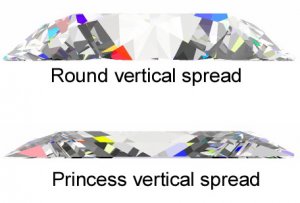

Now how do we allow for the visual spread factor?
I do not think the visual difference accounts for 25% all by itself.
Correct me if I am wrong - but i believe the diameter of a 11.3mm round = the same spread diameter as a 10mm square.
If my logic is correct then the difference in diameter of a round to a square = 11.3% and i assumed a weight difference of 25% to be roughly equivalent - SO????? can I subtract 25%- 11.3% = 13.7% being the difference factor for favoring the brighter round?
Now I am making things confusing - and I know that is not correct because i am not allowing for voume / weight. And the 25% is an intuitive guess backed up with a teeeny bit of surveying.
When we get this all worked out we can distill it down to 1 small entry in FAQ


But i must warn you - I am yet to throw in the vertical spread factor

- Joined
- Aug 29, 2003
- Messages
- 15,808
By points:Date: 1/8/2005 5:507 AM
Author: Garry H (Cut Nut)
Correct me if I am wrong - but i believe the diameter of a 11.3mm round = the same spread diameter as a 10mm square. (#1)
If my logic is correct then the difference in diameter of a round to a square = 11.3% (#2)
and i assumed a weight difference of 25% to be roughly equivalent -
SO????? can I subtract 25%- 11.3% = 13.7% being the difference factor for favoring the brighter round? (#3)
...
But i must warn you - I am yet to throw in the vertical spread factor (#4)
#1 - sure by calculation (the two look like the picture below)
#2 - not sure where teh 11.3% comes from. The percentage difference between 11.3 and 10 is 12.2% (from formula max-min/average; there are other recipes for this too...)
#3 - not sure at all. If those two percentages are considered alternative representations for a qualitative concept, they are supposed to be treated as qualitative measures. Meaning, operations with them are tricky. say, the % are no longer % of the same stuff to be able to add tem up.
When doing so regardless, the operation assumes percentage points to be equivalent: here 1% observed size difference equivalent to 1% diameter difference. I guess the point was that these are not the same.
It seems to me that the point to be proved here remains that brightenedd makes diamonds look bigger. Ok. Agreed. There must be some other way to work that one out

#4 - Great. Of course these are 3D objects. Higher rings seem to be considered more "impressive" than lower settings (don't really agree, but keep hearing this), and surely surface area is not the ultimate way to consider "size" of something three dimensional. I'd like to consider this separately...it may make things complicated indeed 'cause crown height actually ads to the volume and weight of stones of same size. So if some measure of "vertical spread" is added mecanically to another of surface (diameter, anythig function of surface area) it would just become a confounding factor (meaning, some stones that get high mark for spread get low mark for crown height and the other way around - the two cases cannot be told apart in an additive index hence the name "confounding factor". There must be some way out... let me think a bit... I did answer about this one in a couple of posts though.

Anyway, I would like to get a larger sample so sizes get to overlap (as is, there are no squares as large as the rounds above 2 cts in the pack used).

- Joined
- Aug 15, 2000
- Messages
- 18,484
Ana my %''s above are mush. Forget them.
This image has its weights and spread sizes added - it is more meaningful.
0.90ct Round 6.07x6.12 = 29.1mmS
1.23ct Princess 5.64x5.38 = 30.3mmS
1.07ct Round 6.59x6.63 = 33.8mmS
1.47ct Princess 6.08x5.97 = 36.3mmS
Boys tend to think the rounds looked heap bigger, the girls thought the princess were a tiny bit bigger but both girls thought the 1.07ct Round was heaps bigger than the 1.23ct Princess.
So based on that and my own previous experiances of showing and comparing princess cuts to rounds - I am happy with my initial gut feel estimate of plus 25% more for equivalent carat weight for a princess to look the same size as a round.
But I would like to devise a way to test this in more detail
Ana - i think for your survey approach it would be better to use more frequently purchased center stones - say .50ct to 1.5ct D-J VS1-SI2 and do not preselect for cut quality - just use the available goods. We may need Leonids help to get some data since he now has a 200 limit on searching.
How can we move forward?
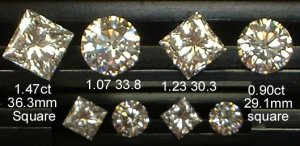
This image has its weights and spread sizes added - it is more meaningful.
0.90ct Round 6.07x6.12 = 29.1mmS
1.23ct Princess 5.64x5.38 = 30.3mmS
1.07ct Round 6.59x6.63 = 33.8mmS
1.47ct Princess 6.08x5.97 = 36.3mmS
Boys tend to think the rounds looked heap bigger, the girls thought the princess were a tiny bit bigger but both girls thought the 1.07ct Round was heaps bigger than the 1.23ct Princess.
So based on that and my own previous experiances of showing and comparing princess cuts to rounds - I am happy with my initial gut feel estimate of plus 25% more for equivalent carat weight for a princess to look the same size as a round.
But I would like to devise a way to test this in more detail
Ana - i think for your survey approach it would be better to use more frequently purchased center stones - say .50ct to 1.5ct D-J VS1-SI2 and do not preselect for cut quality - just use the available goods. We may need Leonids help to get some data since he now has a 200 limit on searching.
How can we move forward?

- Joined
- Aug 29, 2003
- Messages
- 15,808
Date: 1/9/2005 6:505 PM
Author: Garry H (Cut Nut)
How can we move forward?
Yeah... I abandoned statistics after quite a bit of time running searches at 1 point weight intervals. Taking stones between 0.7 and 1.6 cts, there are about 3-4 thousand quotes per color&clarity - not something easy to handle from my side of the screen.
With all numbers in one place and using a common denominator for the grades (say all GIA and AGA for cut - since these apply across shapes), something similar to those charts is straightforward to devise. My hunch is that the premium on spread and brilliance for fancies (princess, but not only) makes rounds a safe bet for quality overall. Price differentials could be used to test (~ weekly generalize) empirical observation.
However, incorporating any measure of optics in a survey based on PS database quotes is a serious complication, I think. It would mean guessing ranges of GIA parameters with high probability of top optics - as much as the AGS princess cut grades have done. This may be avoided by careful design of methodology... if desired. Anything can.
For example...
There surely is a simple way to justify the assumption that the round outline is necessary (geometrically speaking) to maximize optics. Now, with this starting point, price differentials become a gauge for market recognition of the looks. You know what ? I believe it... And a historic argument is very natural to support this.
Then, your picture (and perhaps the results of a like-minded PS poll) could be used to establish what number is the smallest significant visual difference for this size range. It can't be half a square milimeter ... the results of your observation seem to suggest that such size differential is different between diamonds of same shape or different. Anyway, this is a matter of perception very suitable for empiric survey. Price statistics show that spread is a price factor (=to some extent, diamonds are priced by size). The two results can be put together.
And there must be other ways to deal with this too.

Regent Cut
Rough_Rock
- Joined
- Jan 9, 2005
- Messages
- 4
Hi Rosy,
To answer your question:
A well cut round stone of 2ct should be above 8mm diameter.
With Princess cuts it is much more complicated.
If you have a 2ct Princess of Israeli make you will have it with a flat crown and a big table in order to get the biggest yield from the rough. By then normally you should have a bigger stone then a 2ct round (+/- 8.10mm) table 75% depth 65%.
If you take a "British" make for rounds, you''ll have a very large diameter and small weight. I.e. 2ct Round with 11% crown and 67% table will be less attractive in brilliance of the stone but will more look like a 2.5ct round with 8.6mm.
As you can see, there are a lot of factors to determine which one will be bigger, it all depends on the taste of the cutomer.
I hope I have helped you understand.
Greetings,
Regent Cut
To answer your question:
A well cut round stone of 2ct should be above 8mm diameter.
With Princess cuts it is much more complicated.
If you have a 2ct Princess of Israeli make you will have it with a flat crown and a big table in order to get the biggest yield from the rough. By then normally you should have a bigger stone then a 2ct round (+/- 8.10mm) table 75% depth 65%.
If you take a "British" make for rounds, you''ll have a very large diameter and small weight. I.e. 2ct Round with 11% crown and 67% table will be less attractive in brilliance of the stone but will more look like a 2.5ct round with 8.6mm.
As you can see, there are a lot of factors to determine which one will be bigger, it all depends on the taste of the cutomer.
I hope I have helped you understand.
Greetings,
Regent Cut
- Joined
- Aug 15, 2000
- Messages
- 18,484
bump - From this thread: https://www.pricescope.com/community/threads/princess-vs-round-cut-size-comparison.30688/
Garry - Is this the thread you were thinking of?
Matatora
Yes thx Matatora

Garry - Is this the thread you were thinking of?
Matatora
Yes thx Matatora

- Status
- Not open for further replies. Please create a new topic or request for this thread to be opened.
Did You Miss the April 2024 Jewels of the Weeks? Did You Miss the April 2024 Jewels of the Weeks? - 04/26
Did You Miss the April 2024 Jewels of the Weeks? - 04/26

Did You Miss The Throwback Thursdays For April 2024?
Did You Miss The Throwback Thursdays For April 2024? - 04/25


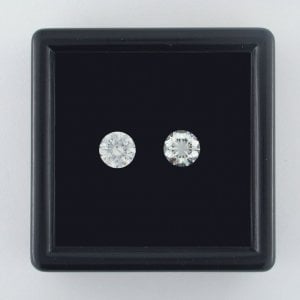
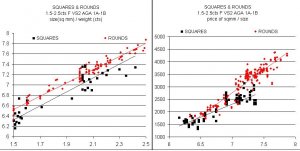

300x240.png)